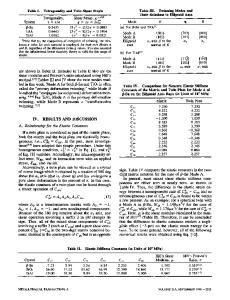Microscale elastic strain evolution following damage in Ti-SiC composites
- PDF / 1,084,759 Bytes
- 7 Pages / 612 x 792 pts (letter) Page_size
- 37 Downloads / 333 Views
I. INTRODUCTION
THE transfer of load from a broken fiber to the rest of a composite as it is deformed is one of the fundamental micromechanical processes determining composite strength, lifetime, and fracture toughness. It is a complex process that depends on fiber/matrix interface properties, the constitutive behavior of matrix and fibers, the geometric arrangement of fibers, fiber volume fraction, and fiber strength distribution. This process is further complicated since the in-situ mechanical properties of the constituents are significantly different from those of their monolithic forms,[1,2,3] e.g., yield strength can increase 2 to 4 times in some composites.[4] These differences include (1) constraints imposed by neighboring phases; (2) changes in microstructure due to altered processing conditions; (3) thermal residual stresses due to coefficient of thermal expansion mismatch between different phases; and, in some cases, (4) high dislocation densities near the fiber/matrix interface.[4] In composites, the macroscopic stress-strain curves obtained by conventional means result from the codeformation of the individual phases making it impossible to determine the phase specific in-situ constitutive behavior. Typical composite deformation includes collective nucleation and evolution of damage, fiber fractures, matrix fractures, and plasticity, as well as interface separation and sliding. In order to predict the strength and lifetime of a fiber composite, the load transfer from broken fibers to the surrounding intact material must be understood. This requires accurate determination of stress-strain evolution at the scale of microstructure—usually on the order of the fiber diameter. JAY C. HANAN and GEOFFREY A. SWIFT, Graduate Students, and ¨ STU ¨ NDAG, Assistant Professor, are with the Department of ERSAN U Materials Science, California Institute of Technology, Pasadena, CA 91125. Contact e-mail: [email protected] IRENE J. BEYERLEIN, Staff Member, is with the Los Alamos National Laboratory, Los Alamos, NM 87545. JONATHAN D. ALMER, ULRICH LIENERT, and DEAN R. HAEFFNER, Staff Members, are with the Argonne National Laboratory, Argonne, IL 60439. Manuscript submitted February 26, 2002. METALLURGICAL AND MATERIALS TRANSACTIONS A
In-situ measurements of stress/strain can then be used to validate and refine predictive micromechanics models. In special cases, this has been achieved using optical methods such as micro-Raman and piezospectroscopy.[4–8]. These studies provided valuable insight about fiber strains in damaged composites at length scales approaching several m. However, in most of these studies, either the matrix could not be characterized or only shallow surface regions were investigated. The following describes the use of X-ray microdiffraction to determine the phase specific in-situ load transfer and damage evolution under applied tensile stress in a metal matrix composite (MMC). Synchrotron X-rays were required to obtain the intensity to reduce the beam size below 100 ⫻ 100 m2 while maintaining sufficient
Data Loading...











